Fuel Sender Assembly Replacement W/O FFS
Tools Required
| • | J 37088-A Tool
Set, Fuel Line Quick Connect Separator |
Removal Procedure (Left or Right)
Caution: Unless directed otherwise, the ignition and start switch must be in the OFF or LOCK position, and all electrical loads must be OFF before servicing
any electrical component. Disconnect the negative battery cable to prevent an electrical spark should a tool or equipment come in contact with an exposed electrical terminal. Failure to follow these precautions may result in personal injury and/or damage to
the vehicle or its components.
- Disconnect the negative battery cable.
- Relieve the fuel system pressure. Refer to the
Fuel Pressure Relief
.
Caution: To avoid any vehicle damage, serious personal injury or death when major components are removed from the vehicle and the vehicle is supported by a
hoist, support the vehicle with jack stands at the opposite end from which the components are being removed and strap the vehicle to the hoist.
- Raise the vehicle. Refer to
Lifting and Jacking the Vehicle
in General Information.
- Remove the rear wheel and tire assembly. Refer to
Tire and Wheel Removal and Installation
in Tires and Wheels.
- Clean all of the fuel connections and the surrounding areas before disconnecting
the fuel pipes in order to avoid possible contamination of the fuel system.
- Drain the fuel tanks. Refer to
Fuel Tank Draining
.
- Remove the fuel tank shield.
- Mark or identify each fuel pipe in order to aid in installing the pipes
in their original positions.
- Disconnect the quick-connect fittings from the fuel sender. Refer to
Plastic Collar Quick Connect Fitting Service
.
- Cap all of the fuel pipes.
- Disconnect the fuel sender electrical connector.
- Remove the fuel tank strap.
- Support the fuel tank.
- Remove the fuel sender attaching bolts.
- Remove the float arm retaining clip and the float arm for the left fuel
sender only.
- Carefully remove the fuel sender with the gasket.
- Clean the gasket sealing surfaces.
Installation Procedure (Right)
- Inspect the fuel sender gasket for damage and replace if necessary.

Important: Do not bend or twist the float arm.
- Insert the float arm through the fuel tank opening.
- The fuel sender may need to be rotated in order to facilitate the installation.
- Align the fuel sender gasket tab (2) with the fuel sender cover
mark (1).
- Align the fuel sender cover mark (1) with the fuel tank mark.

- Hand tighten the fuel sender attaching bolts until finger tight.
Notice: Refer to Fastener Notice in the Preface section.
- Tighten the fuel sender assembly attaching bolts in sequence.
Tighten
Tighten the bolt to 7 N·m (62 lb in).
- Connect the fuel sender fuel feed pipe (1) (from the jet pump
to the left tank, and the fuel feed rear crossover pipe (2) from the left
tank to the jet pump). Refer to
Plastic Collar Quick Connect Fitting Service
.

- Connect the fuel sender electrical connector.
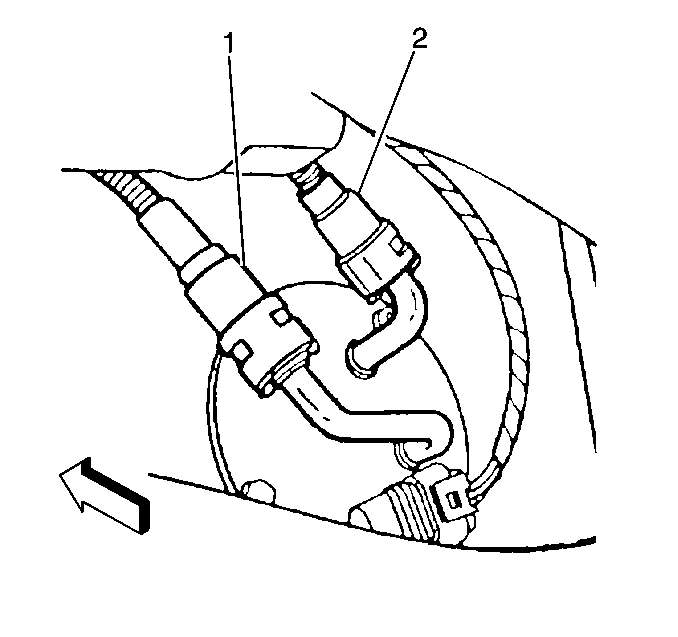
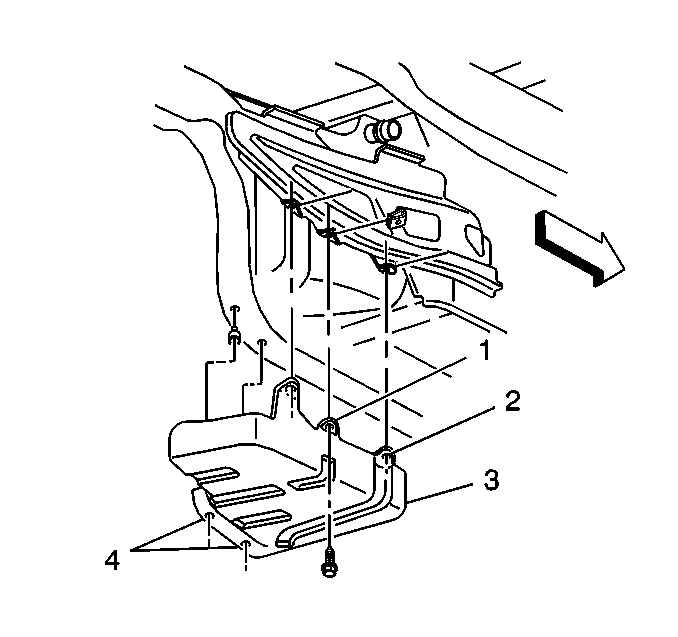
- Install the fuel tank strap (3).
- Install the fuel tank strap bolts (1, 2, 4).
Tighten
| • | Tighten the bolt (2) to 25 N·m (18 lb ft). |
| • | Tighten the bolt (1) to 25 N·m (18 lb ft). |
| • | Tighten the remaining bolts (4) to 25 N·m (18 lb ft). |

- Install the fuel tank shield (1).
- Install the fuel tank shield mount bolt (2).
- Install the fuel tank shield mount nut (3).
Tighten
| • | Tighten the fuel tank shield mount bolt to 25 N·m (18 lb ft). |
| • | Tighten the fuel tank shield mount nut to 12 N·m (106 lb in). |
- Install the rear wheel and tire assembly. Refer to
Tire and Wheel Removal and Installation
in Tires and Wheels.
- Lower the vehicle.
- Refill the fuel system.
- Install the fuel filler cap.
- Connect the negative battery cable.
- Perform the following procedure in order to inspect for leaks:
| 20.1. | Turn the ignition switch ON for 2 seconds. |
| 20.2. | Turn the ignition switch OFF for 10 seconds. |
| 20.3. | Turn the ignition switch ON. |
| 20.4. | Inspect for fuel leaks. |
- Program the transmitters. Refer to
Transmitter Programming
in Keyless Entry.
Installation Procedure (Left)
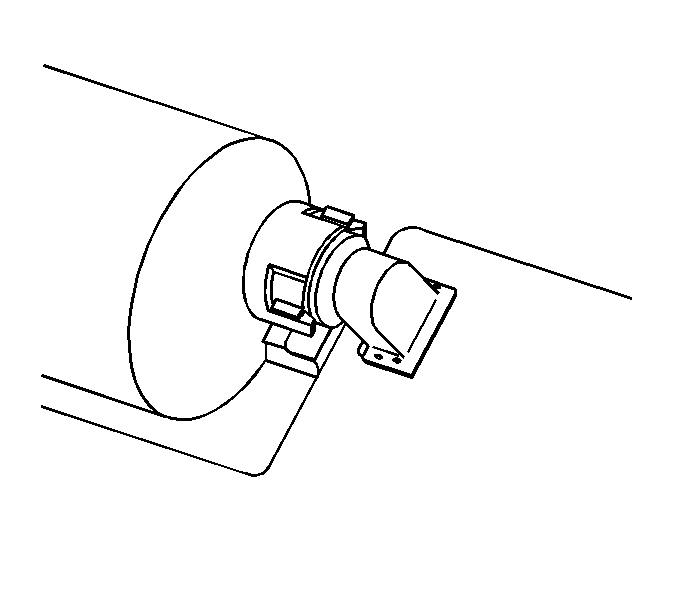
- Install fuel pump strainer in the same position
as noted during disassembly. Push on the outer edge of the strainer ferrule until
the strainer is fully seated.
- Install a sender gasket on the fuel sender.
- Insert the fuel sender through the fuel tank opening.
- The fuel sender may need to be rotated in order to facilitate the installation.
Important: Do not bend or twist the float arm.
- Insert the float and the float arm into the fuel tank opening.
- Install the float arm retaining clip.
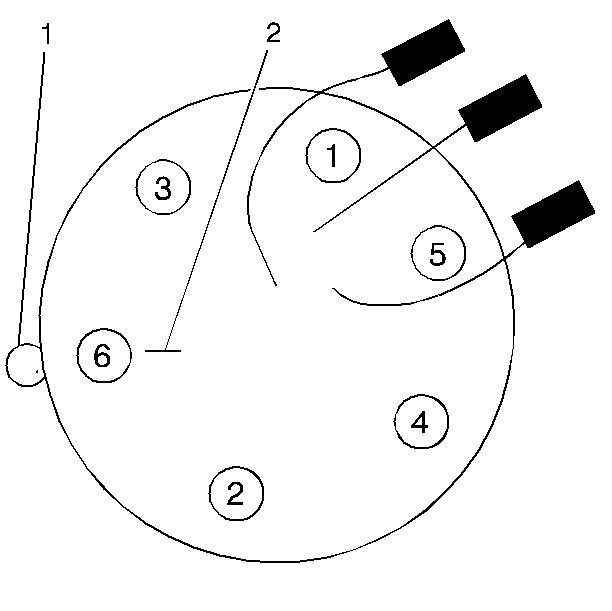
- Align the fuel sender gasket tab (1)
with the fuel sender cover mark (2).
- Align the fuel sender cover mark (2) with the fuel tank mark.
- Tighten the fuel sender attaching bolts until the bolts are finger
tight.

- Tighten the fuel sender assembly attaching
bolts in proper sequence.
Tighten
Tighten bolts to 7 N·m (62 lb in).
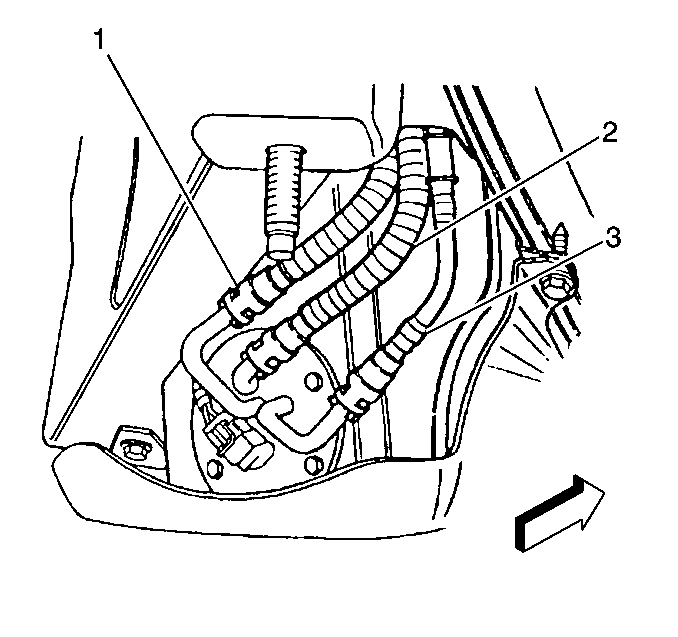
- Connect the fuel sender fuel feed pipe (1)
from the jet pump to the left tank, to the fuel return rear pipe (2), and
to the fuel feed rear pipe (3). Refer to
Plastic Collar Quick Connect Fitting Service
.
- Connect the fuel sender electrical connector.

- Install the fuel tank strap (3).
- Install the fuel tank strap bolts (1, 2, 4).
Tighten
| • | Tighten the bolt (2) to 25 N·m (18 lb ft). |
| • | Tighten the bolt (1) to 25 N·m (18 lb ft). |
| • | Tighten the remaining bolts (4) to 25 N·m (18 lb ft). |

- Install the fuel tank shield (1).
- Install the fuel tank shield mount bolt (2).
- Install the fuel tank shield mount nut (3).
Tighten
| • | Tighten the fuel tank shield mount bolt to 25 N·m (18 lb ft). |
| • | Tighten the fuel tank shield mount nut to 12 N·m (106 lb in). |
- Install the rear wheel and tire assembly. Refer to
Tire and Wheel Removal and Installation
in Tires and Wheels.
- Lower the vehicle.
- Refill the fuel system.
- Install the fuel filler cap.
- Connect the negative battery cable.
- Perform the following procedure in order to inspect for leaks:
| 23.1. | Turn the ignition switch ON for 2 seconds. |
| 23.2. | Turn the ignition switch OFF for 10 seconds. |
| 23.3. | Turn the ignition switch ON. |
| 23.4. | Inspect for fuel leaks. |
- Program the transmitters. Refer to
Transmitter Programming
in Keyless Entry.
Fuel Sender Assembly Replacement RH W/FFS
Tools Required
J39765-A Fuel Sender
Lock Ring Tool
Removal Procedure
- Disconnect the negative battery cable. Refer to
Battery Negative Cable Disconnection and Connection
in Engine Electrical.
- Remove the right fuel tank. Refer to
Fuel Tank Replacement
.
- Place the fuel tank on a suitable work surface.
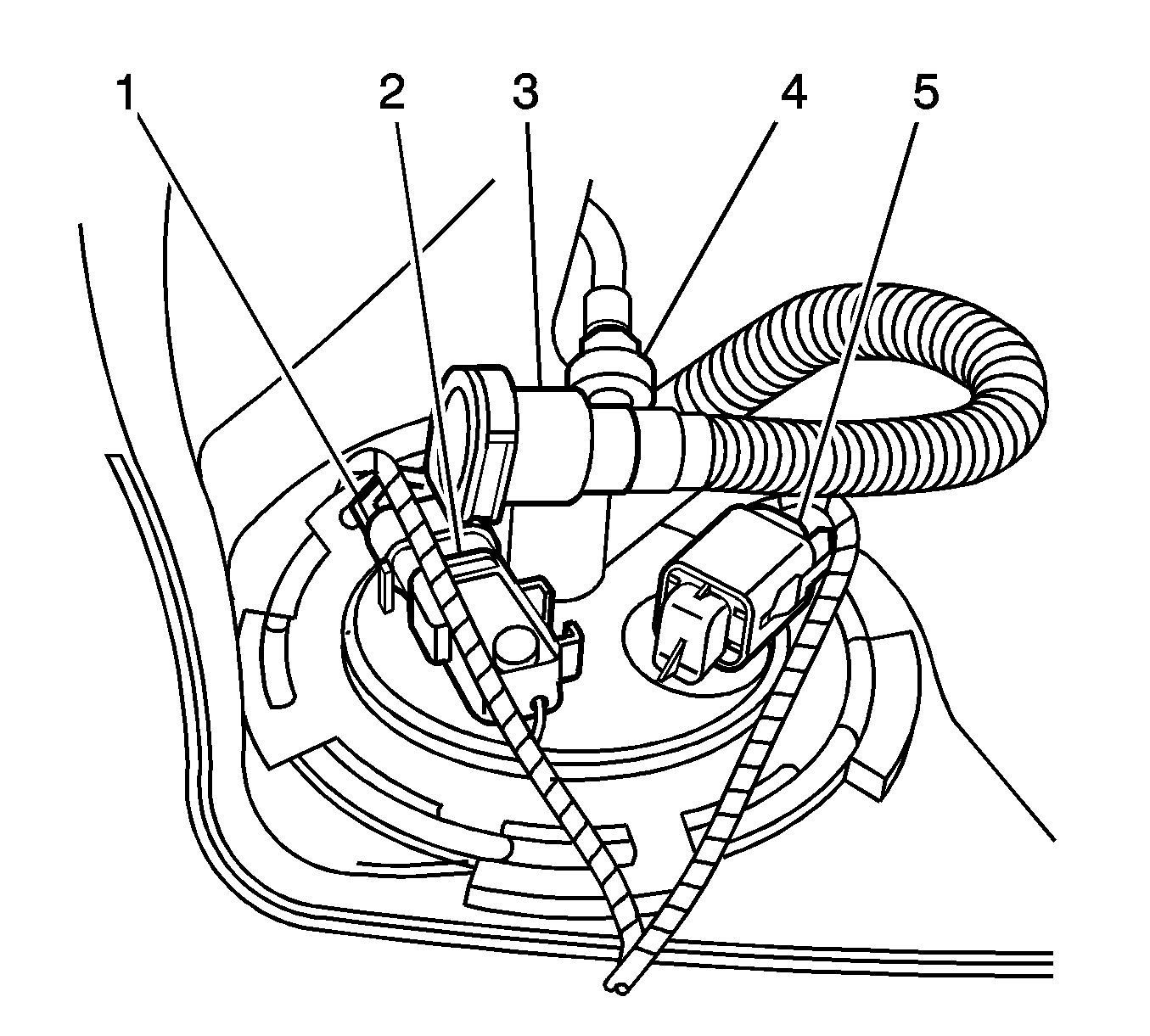
- Disconnect the EVAP purge line (4) from
the fuel pump module.
- Disconnect the fuel pump module harness connector (5).
- Disconnect the FTP sensor harness connector (1).
- If replacing the fuel pump module, remove the FTP sensor (2). Refer to
Fuel Tank Pressure Sensor Replacement
.
- Disconnect the jet line insert connector from the crossover tube to fuel
tank opening.
Important: The fuel pump module is spring loaded and
will spring upward when the locking ring is removed.
- Using the J39765-A
,
remove the fuel pump module locking ring.
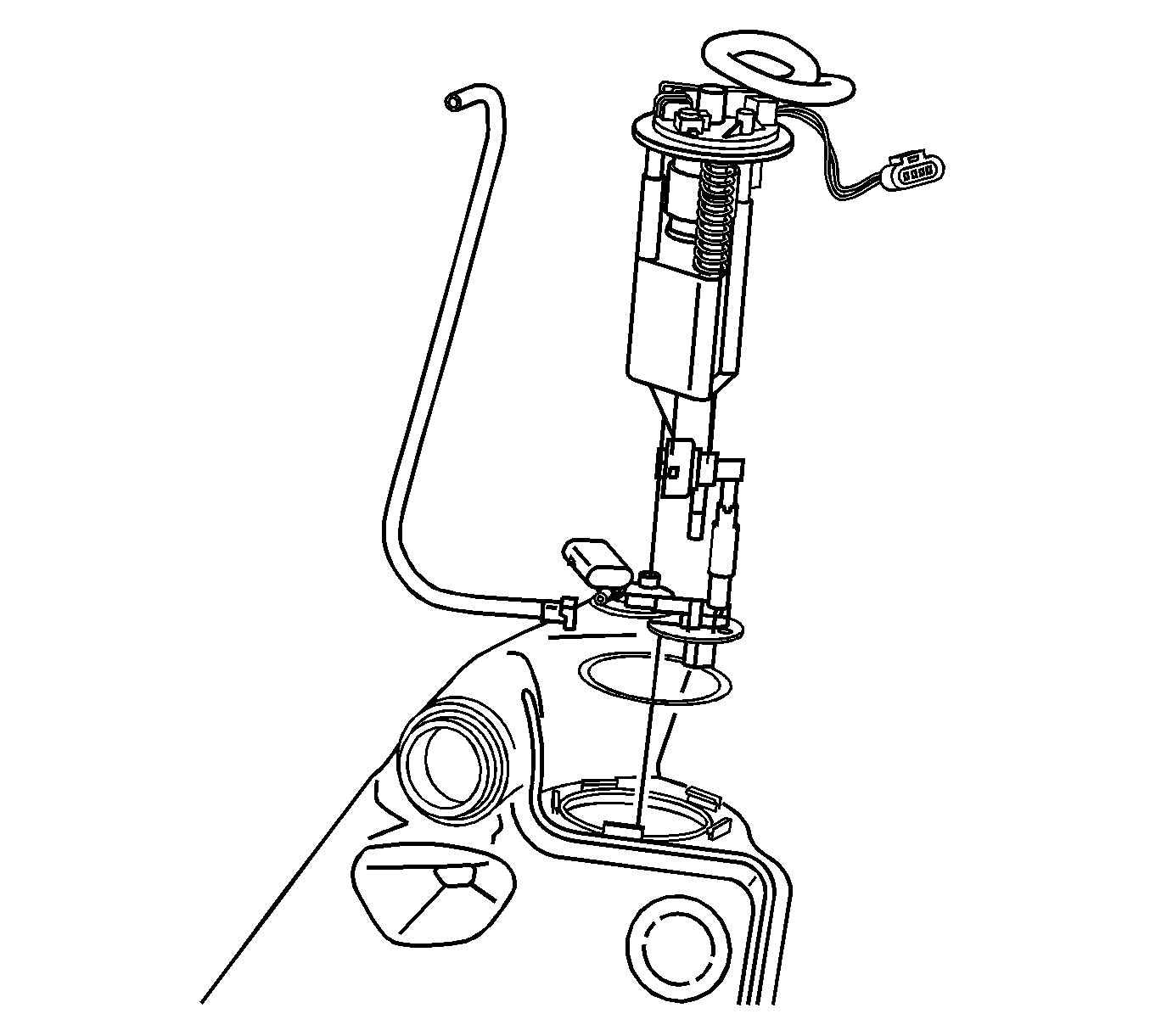
- Carefully remove the fuel pump module from the fuel tank, with the jet lines
connected. Take care not to damage the fuel sender float arm.
- Disconnect the jet line quick-connect connectors from the fuel
pump module, noting the location of the lines for installation.
- Remove the fuel pump module O-ring from the fuel tank opening.
- Remove the jet line insert through the crossover tube to fuel tank opening.
Installation Procedure
- Inspect the jet line insert for damage and replace if necessary.
- Install the jet line insert through the crossover tube to fuel tank opening.

- Install a new fuel pump module O-ring to the fuel tank opening.
Important: Pull on each connector to ensure that the
connectors are properly latched.
- Pull the jet line quick-connectors up through the pump module opening,
connecting the lines to the pump module as previously noted.
- Install the pump module into the fuel tank, taking care not to damage
the float arm.
- Compress and align the fuel pump module, while installing the lock ring.
- Using the J39765-A
, fully lock the fuel pump module lock ring in place.
- Using a DMM, verify the full and empty readings resistance reading of
the fuel pump module. Turn the fuel tank upside down to achieve the full tank reading.
Resistance
| • | Empty 40 ohms resistance |
| • | Full 250 ohms resistance |
Important: Pull the jet line insert connector to ensure
that the insert is properly attached.
- Connect the jet line insert connector into the crossover tube to fuel tank opening.

- If replacing the fuel pump module, install
the FTP sensor (2). Refer to
Fuel Tank Pressure Sensor Replacement
.
- Connect the FTP sensor harness connector (1).
- Connect the fuel pump module harness connector (5).
- Connect the EVAP purge line (4) from the fuel pump module.
- Install the right fuel tank. Refer to
Fuel Tank Replacement
.
Fuel Sender Assembly Replacement LH W/FFS
Tools Required
J39765-A Fuel
Sender Lock Ring Tool
Removal Procedure
- Disconnect the negative battery cable. Refer to
Battery Negative Cable Disconnection and Connection
in Engine Electrical.
- Remove the left fuel tank. Refer to
Fuel Tank Replacement
.
- Place the fuel tank on a suitable work surface.
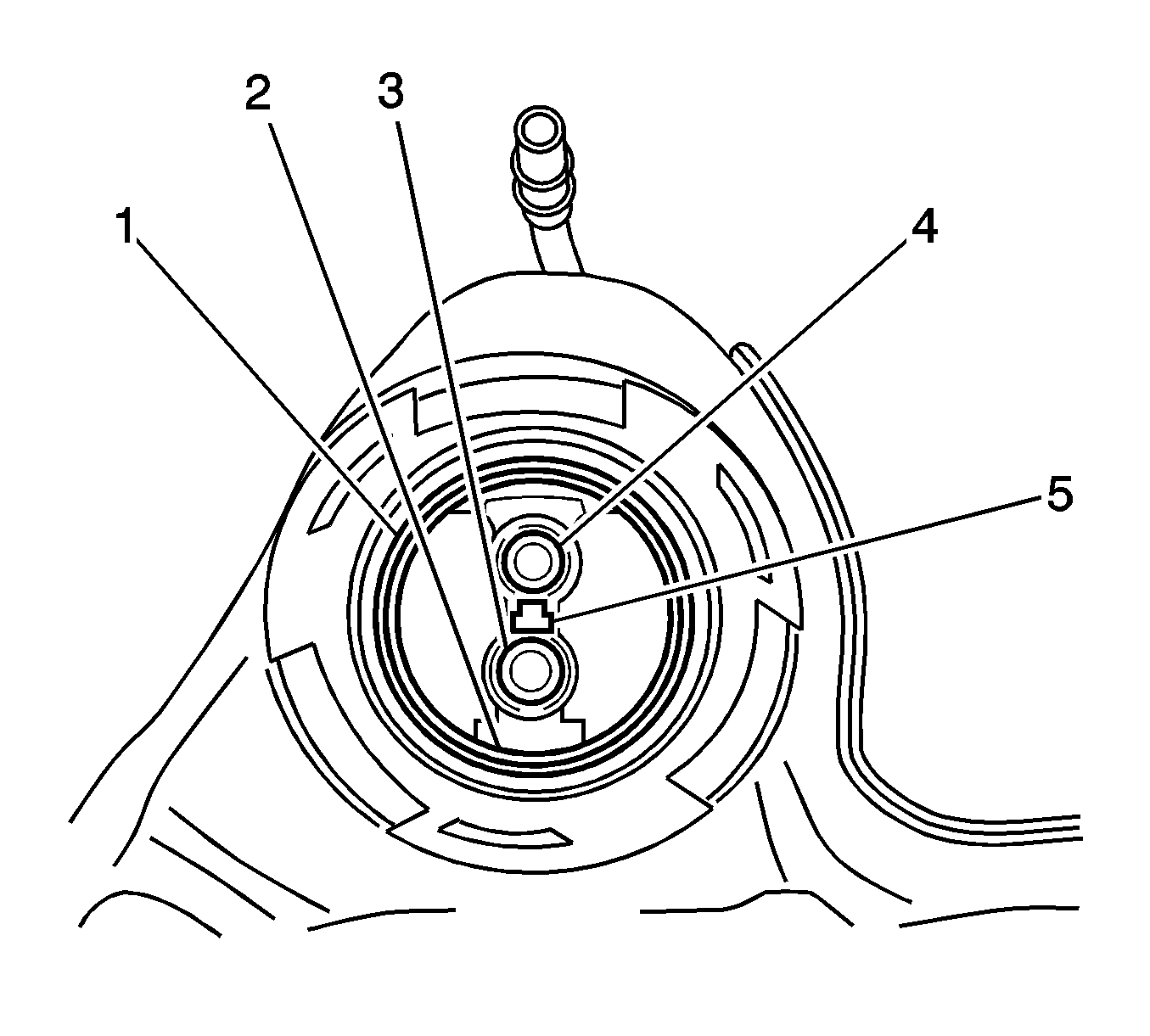
- Disconnect the fuel pump jumper harness
from the fuel pump module.
- Disconnect the jet line insert connector from the crossover tube to fuel
tank opening.
- Disconnect the fuel feed line from the welded clip on the side of the
fuel tank.
Important: The fuel pump module is spring loaded and
will spring upward when the locking ring is removed.
- Using the J39765-A
,
remove the fuel pump module locking ring.
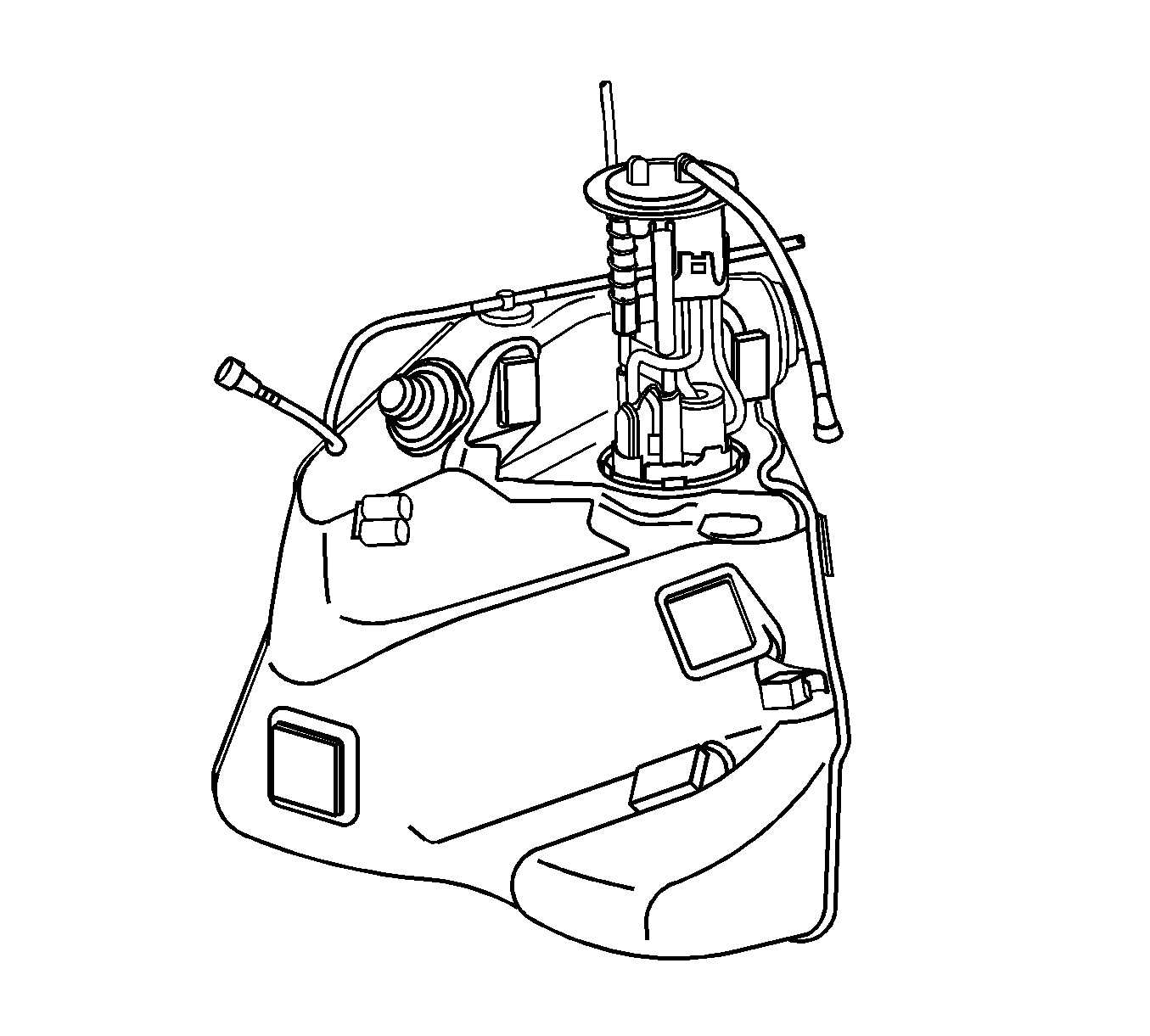
- Carefully remove the fuel pump module from the fuel tank, with the jet lines
connected. Take care not to damage the fuel sender float arm.
- Disconnect the jet line quick-connect connectors from the fuel
pump module inner port.
- Remove the jet line from the module retainer cup. This line has no attached
connector.
- Remove the fuel pump module O-ring from the fuel tank opening.
- Remove the jet line insert through the crossover tube to fuel tank opening.
Installation Procedure
- Inspect the jet line insert for damage and replace if necessary.
- Install the jet line insert through the crossover tube to fuel tank opening.
- Install a new fuel pump module O-ring to the fuel tank opening.
- Place tape around the jet line with the connector. This will permit line
access once the pump module is inserted into the fuel tank.

- Install the pump module into the fuel tank half way , taking care not to damage
the float arm.
- Using the tape as a guide, gently pull the jet line up through the fuel
pump module opening.
- Place the jet line with no connector in the module retainer cup.
- Secure the line into the module retaining clip.
- Remove the tape from the jet line with a connector.
Important: Pull on each connector to ensure that the
connectors are properly latched.
- Connect the jet line quick-connect connectors to the fuel pump module
inner port.
- Compress and align the fuel pump module into the fuel tank, while taking
care not to damage the float arm.
- Install the fuel pump module lock ring.
- Using the J39765-A
, fully lock the fuel pump module lock ring in place.
- Connect the fuel supply line into the weld clip on the side of the fuel
tank.
- Using a DMM, verify the full and empty readings resistance reading of
the fuel pump module. Turn the fuel tank upside down to achieve the full tank reading.
Resistance
| • | Empty tank reading 40 ohms resistance |
| • | Full tank reading 250 ohms resistance |
Important: Pull the jet line insert connector to ensure
that the insert is properly attached.
- Connect the jet line insert connector into the crossover tube to fuel tank opening.

- Connect the fuel pump jumper harness to
the fuel pump module.
- Install the left fuel tank. Refer to
Fuel Tank Replacement
.




















